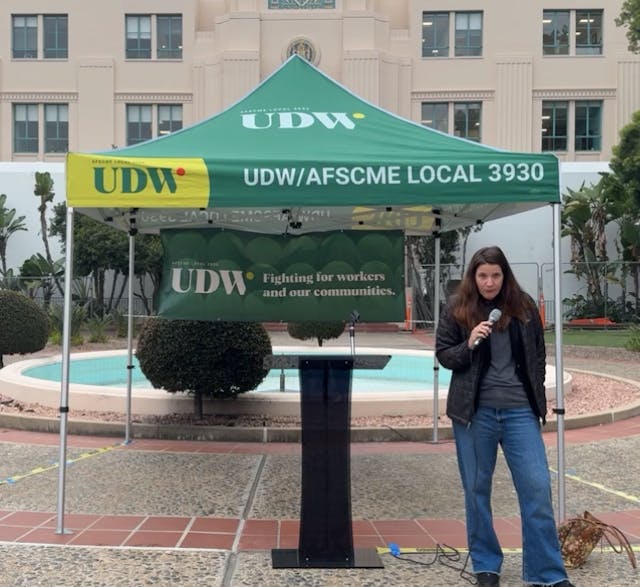The Missing Faces of February
Frontera NorteSur
Martha Cecilia Gomez was visibly shaken as she pleaded for the whereabouts of her daughter. According to the Mexican mother, her 16-year-old daughter Paola Yaneth Alvarez left the family home in the central Mexican state of Aguascalientes the morning of February 1 to go shopping for pork rinds and never returned.
“We don’t know anything about her,” Gomez told FNS. “As the mother of a family, I ask people who might have seen something to come forward, but nobody has” Along with relatives of other missing or murdered persons, Paola’s family members staged a march earlier this month through the state capital of Aguascalientes to press for answers.
The other presumed and confirmed victims spotlighted in the demonstration included Sergio de Lara Quezada, 28, disappeared on August 30, 2011; Maria del Cristal Acevedo Gomez, 29, missing since July 26, 2014; and Cecilia Martinez Mota, murdered in 2014.
In the days following the march, stickers affixed to structures lining one of Aguas-calientes’ main streets asked passerby, “Where is Cristal Acevedo?”
Civil society groups such as the Feminist Collective and the Social and Gender Violence Observatory also participated in a protest designed to call public attention to disappearances. “This is a grave problem nationwide,” Mariana Avila, Observatory coordinator, told reporters.
While Aguascalientes is not known to have experienced the same level of disappearances of Mexican states like Chihuahua or Guerrero, the issue is of growing concern to Avila and other human rights activists.
According to Avila’s group, data released by the Aguascalientes attorney general’s office (PGJE) in September 2014 reported the disappearance of 239 women and 135 men. Yet the same office earlier stated that 200 people in total were missing from 2007 to 2014, according to Observatory members.
In an effort to get a more accurate picture of the local problem, the non-governmental organization is in the process of requesting updated information.
In an interview with FNS, Avila recognized that the PGJE has committed to harmonizing the state’s investigative procedures with national ones by May 2015. But she criticized the PGJE for shortcomings in following protocols like the Amber and Alba alert systems designed to speed up police actions for endangered minors and adults, respectively.
“To the authorities they are simply missing persons,” Avila contended.
Paola Alvarez’s relatives questioned policing methods, too. Similar to the friends and family of Erika Cueto (see article link below) in Puerto Vallarta, Jalisco, Martha Gomez recounted how her family was bounced between three separate law enforcement offices-one in the state of Jalisco and two in Aguas-calientes.
Paola disappeared in Lumbreras Cienguilla, a rural community not far from the state line with Jalisco. Questioning priorities, Gomez said authorities focused on Paola’s life before February 1, instead of the time after her disappearance. Law enforcement officials from Jalisco have since contacted the family by phone while their counterparts in Aguascalientes have asked the mother if she has learned anything more about her daughter, Gomez said.
Elia Patricia Lopez, Martha Gomez’s cousin, added that police suspected Paola “went with the boyfriend.” Gomez, however, insisted that her daughter did not have a boyfriend at the moment of her disappearance. On her walk to and from the store Paola would have passed by a circus that was initially the focus of a police probe, which did not bear any results, the two women said. The circus has since moved on, they added.
“There is no serious line of investigation to indicate where she is,” Lopez lamented.
According to an Amber Alert for Paola now posted online, personnel of the store where the missing teen was headed reported seeing her.
Sergio Acevedo, father of Cristal Acevedo, has spent months anguishing over the fate of his daughter, who disappeared last summer while leaving work at a department store. The missing woman left behind a 12-year-old daughter.
“’The earth swallowed her up’,” is how Acevedo remembered Aguascalientes Attorney General Felipe Munoz summarizing what might have happened to his daughter. Reached by phone, Acevedo expressed frustration at the course of the police investigation. In less than one year, the officials in charge of his daughter’s case have been changed three times, he said.
“They don’t have anything concrete. They pass the ball from one to the next,” Acevedo told FNS. Unlike the rewards offered by the federal attorney general’s office for information on some missing persons, no compensation is being offered for tips regarding Cristal and many other missing persons in Aguascalientes, he said.
“If I had the money, I’d offer a reward, but I can’t,” Acevedo said. “I’m a person with scarce resources.”
On Tuesday, February 24, Acevedo and a small group of supporters and relatives of other disappeared persons conducted another protest in Aguascalientes’ main plaza, where state officials were present. No official bothered to give any answers to the group, Acevedo later complained.
Lopez contended that public indifference is a big obstacle to encountering Paola and other disappeared persons, because many people tend to shrug off the matter if it does not directly concern them.
In Jalisco, on the borderline of Aguascalientes, another family also protested in the streets this month demanding answers.
Curiously, 13-year-old Maria Guadalupe Vazquez disappeared on February 2, the day after Paola vanished. The school girl reportedly went missing after leaving home to go to an Internet café in her home town of Encarnacion de Diaz, or La Chona as it is popularly known.
In some ways, the Vazquez case has proceeded in a manner similar to the disappearances of Paola Alvarez and Erika Cueto. According to press accounts, 72 hours passed before the Jalisco state prosecutor’s office initiated a formal investigation of Maria’s disappearance even though an Amber Alert for the girl could have been issued almost immediately because of her age. In La Chona, a boyfriend is also cast as a possible suspect.
According to Lopez, Paola’s family was also told to wait 72 hours before filing a complaint that would activate an investigation, even though once again, the person in question is a minor.
Rumors that between two and four bodies were recovered from a local reservoir during a police search for Maria Vazquez were publicly refuted by La Chona’s public safety chief. “It’s a lie, German Lopez Serrano told the Aguascalientes edition of La Jornada. “It is totally peaceful here. Nothing is going on.”
But in the disappearances of Maria Vazquez and Paola Alvarez, political geography could be an important starting point.
Several sources described La Chona as a strategic point in an organized crime corridor, as well as the gateway to Los Altos de Jalisco- another hotbed of illicit activity. The death of a longtime regional capo three years ago triggered violent competition for the “plaza,” which showed signs of subsiding more recently when one individual seemed to have gained the upper hand, said a source who spoke off the record to FNS.
Last June, El Heraldo de Aguascalientes and other Mexican media reported on the arrests of three men connected to the disappearance and execution of eight people who were found secretly buried in La Chona.
La Chona’s public safety problems follow a national pattern of state border regions resembling no-man’s lands, vividly illustrated by troubles along the frontiers of Nayarit and Jalisco, Guerrero and Michoa-can and Coahuila and Durango, among other places. The political divisions can mean the predominance of one criminal group over another, and potentially hamper and confuse law enforcement agencies with differing jurisdictions.
Avila ventured that a regional human trafficking network could be behind some of the women’s disappearances in and around Aguascalientes. Previous cases of missing or murdered women in the state have been generally linked to other forms of patriarchal violence and impunity, Avila said. In contrast, the disappearances of men have been more clearly connected to organized crime- at least until now- she said.
For Avila, Mexico’s obligations under human rights treaties and international law come into play.
Avila cited the 1979 UN Convention for the Elimination of All Forms of Discrimination against Women (CEDAW) and the Organization of American States’ 1994 Convention of Belem do Para, international accords that require agreeing states including Mexico to prevent and punish violence against women.
She recalled the 2009 Campo Algodonero decision of the Inter-American Court of Human Rights that found the Mexican state accountable for human rights violations in the murders of three women in Ciudad Juarez, in addition to the larger pattern of violence against women in the border city and the state of Chihuahua.
“Mexico has not complied with these,” Avila maintained. “The international resolutions don’t matter to the Mexican government. We see that in the case of Campo Algodonero.”
More than five years after the Inter-American Court’s verdict, the Mexican government has completed some parts of the obligatory Campo Algodonero sentence, but not brought the real killers to justice or sanctioned officials responsible for an emblematic miscarriage of justice replete with the fabrication of tortured scapegoats, the misidenti-fication of victims and the harassment of victims’ relatives.
As in other Mexican states, a local human rights commission operates in Aguascalientes. Until now, the official agency has not had a direct role in the disappearances of either men or women. Avila said her group has conducted discussions with the commission, but “nothing concrete” has emerged from the talks so far.
Eduardo Jesus Martin, Aguascalientes Human Rights Commission (CEDHA) president, told FNS that he invited the Observatory to file a formal complaint regarding disappearances with the commission’s staff. Absent an investigation, the CEDHA circulates photos and personal information about disappeared persons to the network of state human rights commissions, Martin said.
No family members of disappeared persons have approached the commission so far, the CEDHA’s president said. Martin added that he encountered the local family members of two disappeared persons during a recent meeting in Aguascalientes featuring the presence of poet and national anti-violence activist Javier Sicilia.
In the broader national and international context, Avila judged recent developments, including the Pena Nieto administration’s quick criticisms of the United Nations Committee on Enforced Disappearances’ assessment this month of the Mexican government’s actions on forced disappearances as below par, as auguring bad for human rights in her country.
“It is an important symbolism because it says the international community doesn’t matter when it comes to forced disappearances,” Avila said. “The government is saying it is not responsible, it’s organized crime. It’s a clear message that they will not lose control and accept recommendations. This puts us in a defenseless position.”
With the support of others, Cristal Acevedo’s father said he will continue struggling and not allow himself to get worn down by desperation. The issue goes far beyond his family, touching the lives of the family members of the more than 22,000 people officially reported as disappeared in Mexico, he said.
“But I think it’s more, because many people don’t report them,” Sergio Acevedo added. “It’s not only Cristal. There are many children, young people and old people who are disappeared.”






